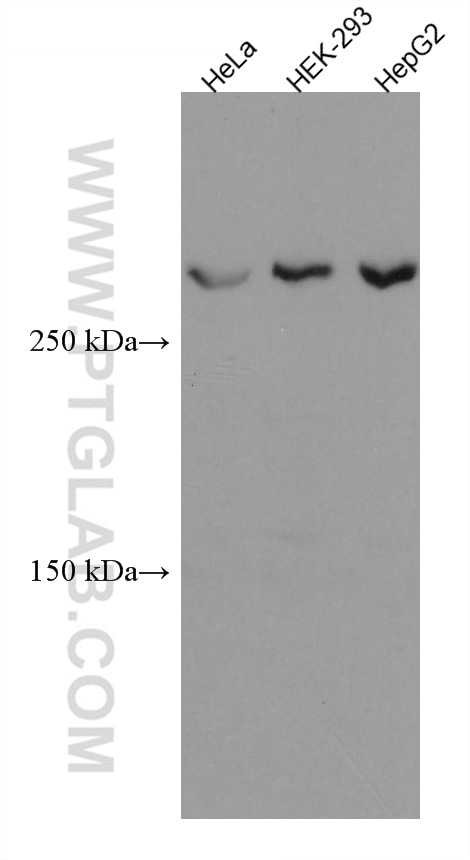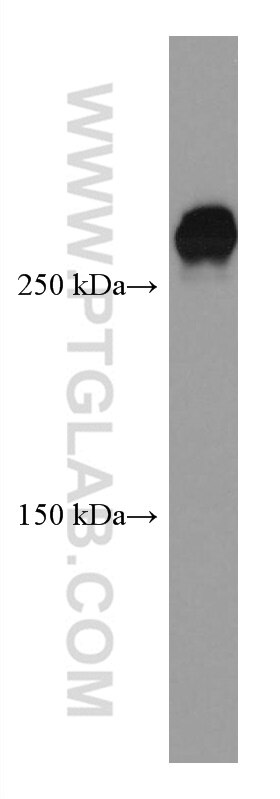Tested Applications
| Positive WB detected in | HeLa cells, HSC-T6 cells, HEK-293 cells, HepG2 cells |
Recommended dilution
| Application | Dilution |
|---|---|
| Western Blot (WB) | WB : 1:1000-1:5000 |
| It is recommended that this reagent should be titrated in each testing system to obtain optimal results. | |
| Sample-dependent, Check data in validation data gallery. | |
Published Applications
| WB | See 4 publications below |
| IF | See 1 publications below |
Product Information
67586-1-Ig targets ATM in WB, IF, ELISA applications and shows reactivity with human, rat samples.
| Tested Reactivity | human, rat |
| Cited Reactivity | human, rat, pig |
| Host / Isotype | Mouse / IgG1 |
| Class | Monoclonal |
| Type | Antibody |
| Immunogen |
CatNo: Ag30001 Product name: Recombinant human ATM protein Source: e coli.-derived, PET28a Tag: 6*His Domain: 1059-1361 aa of BC137169 Sequence: SSEFENKQALLKRAKEEVGLLREHKIQTNRYTVKVQRELELDELALRALKEDRKRFLCKAVENYINCLLSGEEHDMWVFRLCSLWLENSGVSEVNGMMKRDGMKIPTYKFLPLMYQLAARMGTKMMGGLGFHEVLNNLISRISMDHPHHTLFIILALANANRDEFLTKPEVARRSRITKNVPKQSSQLDEDRTEAANRIICTIRSRRPQMVRSVEALCDAYIILANLDATQWKTQRKGINIPADQPITKLKNLEDVVVPTMEIKVDHTGEYGNLVTIQSFKAEFRLAGGVNLPKIIDCVGSDG Predict reactive species |
| Full Name | ataxia telangiectasia mutated |
| Observed Molecular Weight | 310-350 kDa |
| GenBank Accession Number | BC137169 |
| Gene Symbol | ATM |
| Gene ID (NCBI) | 472 |
| RRID | AB_2882795 |
| Conjugate | Unconjugated |
| Form | Liquid |
| Purification Method | Protein G purification |
| UNIPROT ID | Q13315 |
| Storage Buffer | PBS with 0.02% sodium azide and 50% glycerol, pH 7.3. |
| Storage Conditions | Store at -20°C. Stable for one year after shipment. Aliquoting is unnecessary for -20oC storage. 20ul sizes contain 0.1% BSA. |
Background Information
The ATM protein is a member of the phosphatidylinositol 3-kinase family of proteins that respond to DNA damage by phosphorylating key substrates involved in DNA repair and/or cell cycle control. It is involved in mitogenic signal transduction, meiotic recombination, detection of DNA damage, and cell cycle control.
Protocols
| Product Specific Protocols | |
|---|---|
| WB protocol for ATM antibody 67586-1-Ig | Download protocol |
| Standard Protocols | |
|---|---|
| Click here to view our Standard Protocols |
Publications
| Species | Application | Title |
|---|---|---|
Food Chem Toxicol DON entry into the nucleus induces DNA damage, apoptosis and cycle arrest in GES-1 cells | ||
CNS Neurosci Ther Multiple sevoflurane exposures during mid-trimester induce neurotoxicity in the developing brain initiated by 15LO2-Mediated ferroptosis | ||
J Mol Med (Berl) High expression of BCAT1 sensitizes AML cells to PARP inhibitor by suppressing DNA damage response | ||
Signal Transduct Target Ther In vivo evaluation of guide-free Cas9-induced safety risks in a pig model |






